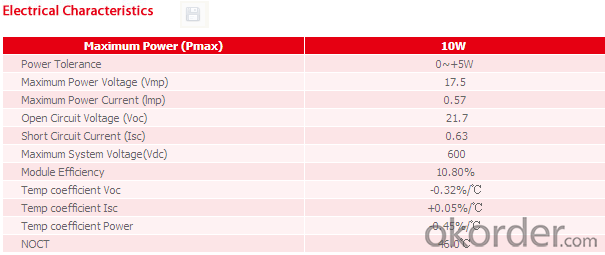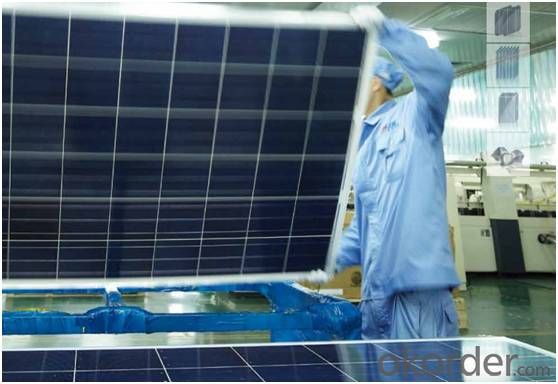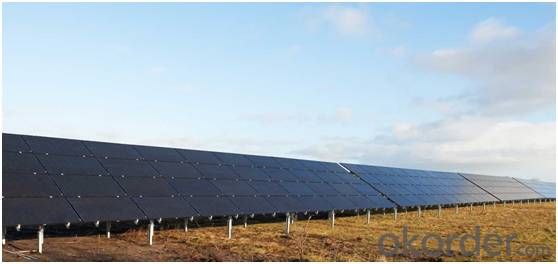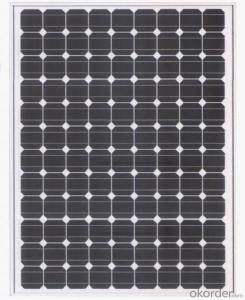Off-grid Solar Panel TDB62.5×125/4-36-P Lower Weight
- Loading Port:
- Ningbo
- Payment Terms:
- TT OR LC
- Min Order Qty:
- 100 carton
- Supply Capability:
- 10000 carton/month
OKorder Service Pledge
OKorder Financial Service
You Might Also Like

Specification:
· Highest performance enabled by higher efficiency monocrystal line cells and the latest Solar Wafer Technology for multicrystal line cells
· Lower weight design which reduces the total system load on a roof, making it ideal for residential customers. Its shape allows for better roof utilization
· Its low weight means easier handling for installers
· Modules are designed to withstand PID (Potential Induced Degradation)*
· High light transmission Anti-Reflective Glass with improved self-cleaning capability
· 0/+5 W Positive power tolerance for reliable power output
Warranty
CNBM Solar provides one of the most comprehensive module warranties in the industry:
· 10 years for product defects in materials and workmanship
· First 12 years for 90% of warranted minimum power
· Remaining 25 years for 80% of warranted minimum power
Certification
CNBM Solar strictly carries out the ISO 9001 quality control methodology and has implemented check points at every step of the production process to ensure our product performance durability and safety. The stringent quality control process has been confirmed by numerous independent agencies and LDK Solar modules earned IEC, TUV and UL certifications.
· IEC:IEC 61215, IEC 61730 (1&2), conformity to CE
· UL 1703 2002/03/15 Ed:3 Rev:2004/06/30
· ULC/ORD-C1703-01 Second Edition 2001/01/01
· UL and Canadian Standard for Safety Flat-Plate
· ISO 9001: 2008 Quality Management Systems
· CEC Listed: Modules are eligible for California Rebates
· PV Cycle: Voluntary module take back and recycling program
· MCS Certificate



FAQ
1. How do I decide which system is right for me ?
For protection from long outages, include a generator or solar panels in your Must solar system. Shorter outages can be handled by a battery-only system.
2. Where my system will be installed ?
Must solar systems are usually wall-mounted near a home's main electrical (circuit breaker) panel.
3. How do I install my system ?
A must solar backup inverter is connected to a home electric system , we will supply detailed installation manual and videos for our customers .
How fast will my system respond to a power outage ?
Must solar inverters typically transfer to battery power in less than 16 milliseconds (less than 1/50th of a second).
What kind of batteries do the systems include ?
Must solar backup electric systems use special high-quality electric storage batteries.
- Q:Has anyone had roof problems caused by rooftop solar panels?
- Rooftop solar panels might cause all sorts of maintenance or poor installation problems but I rather doubt at this point if we can say that there is an issue with solar panels in general that will cause a problem with the roof. Rather solar panels tend to shade a roof on its most exposed side. Without solar panels southern facing roofs will wear out faster than northern facing roofs. Installed solar panels will tend to make the roof last longer.
- Q:Can solar panels be used to power electric vehicles?
- Yes, solar panels can be used to power electric vehicles. Solar panels can convert sunlight into electricity, which can then be stored in a battery and used to power an electric vehicle. This helps reduce dependence on fossil fuels and promotes sustainable transportation.
- Q:can solar panels be on houses? malls?stores? WHAT ABOUT TRAINS?
- Solar panels are, well panels that take solar energy from the sun, and use it as heat or electricity. It is used for many things but depending on the power of the sun and the panel, they can be used for trains,houses to heat them but you need a lot of sun, and they don't work without sun obviously.
- Q:Why can not the solar panel load directly?
- Solar panels because of low power, and the output voltage is extremely unstable, not suitable for load.
- Q:i have a fountain system that has a small electric pump. its made to be close to a house but i want it across the driveway and i dont want to run electrical over there.is there a small solar panel that i can get fairly inexpensive to mount on a nearby tree and be able to plug the pump into it?
- You will need more than a small solar panel to run a pump continuously, unless you don't mind that the pump only comes on during the day while the sun is out. st you need to know what the power demands are of the pump in question. Not only do you need to know the rate of the power draw from the pump, but you will also have to calculate how much power the pump will draw from your solar system every day. You will have to factor in that the sun doesn't shine brightly every day, of course there's also night, so you will need a storage battery, charging system to go along with your solar panel. Now most pumps like the one you described are 20vac. Most solar panels, the batteries, the chargers are 2vdc. In order to get 20vac you will need an inverter. Once again, you will have to make sure that the inverter you get can handle the demands of the pump. A solar system that actually works for you takes some carefull planning, it's not something that you can just hang from a tree. None of what I just descibed will be inexpensive by my definition, so if it were me, I'd dig a trench across the driveway, install some direct bury cable on a GFCI circuit out of my main power panel save a bundle.
- Q:I'm looking into buying solar panels, there are all kinds of ranges of energy output...but my question is, when ti says...say 50 watts of power...does that mean 50 watts a day, an hour, a minute, what?
- A 50-watt rating means the panel will produce 50 watts as long as the standard conditions are maintained. So if you had this bright sun and cool temperatures for 6 hours, the panel would deliver 50 x 6 = 900 watt hours, or a little shy of kilowatt-hour. Kilowatt-hours (kWh) is the reading on your electric bill. However, like most advertising, the 50-watt number is not realistic. They assume that the air surrounding the panel is very cold. 25 watts is a better number to use for this size of panel for engineering purposes.
- Q:How many kilowatts? Would it be enough to power my electric heat?Does one panel cost about $2000.?
- The first thing to understand is that there is nothing complex about a solar panel. It is nothing more than a collection of solar or PV cells on a board that is fitted to the most appropriate part of your home, generally on the roof. There are guides out there that teach you how to build a solar panel and a windmill for just $50, and it’s very easy to make. Best of all, you can save 70% or more on your energy bill, adding up to thousands of dollars each year in savings. I reviewed both free guides and paid guides and have come up with our top to Build your own solar panels.
- Q:Can I add more solar panel let say up to 200 watt and adding two 2 volts battery using the same charges controller and power inverter?
- If you put a black panel on the ground or on your house and don't connect it to anything, it will absorb solar energy (heat) during daylight and release it at night (radiation). Not exactly. Assuming the black panel establishes an equilibrium temperature, it's going to be losing exactly as much heat as it's receiving during the day. Some will radiate out into space, some will conduct or convect into the atmosphere. As a wild guess, maybe 50/50. If you hook up a solar panel in the same place but hook it up to batteries, charge the batteries during sunlight hours and using that energy to electrically heat the home at night. The panels will absorb solar energy during the day but will convert that to electrical energy in the batteries instead of radiating it back into space at night. The panels are only about 4% efficient, so it's the same situation as the pure black panel for 86% of the energy. The remaining 4% will get stored in the batteries and then converted to heat at night. That heat will eventually leak out of the house and warm up the Earth a tiny bit. I think it's much the same situation either way. With the black panel the energy gets radiated / conducted/convected right away. With the solar panel a small percentage is stored and not so much is radiated, mostly conducted and convected. You're partly right as a black panel is going to radiate more into space than a house. But you're taking about maybe some day about 4% of % of the differening radiation/convection/conduction fraction, of the Earth's surface area. Probably not significant.
- Q:Can solar panels be used in multi-story buildings?
- Yes, solar panels can be used in multi-story buildings. They can be installed on the roof of the building or on vertical surfaces such as walls or balconies. The availability of space and the structural integrity of the building are important factors to consider when installing solar panels in multi-story buildings.
- Q:Can solar panels be installed on a historic building?
- Yes, solar panels can be installed on a historic building. However, the installation process may require careful planning and consideration to ensure minimal visual impact and preservation of the building's historical integrity. Collaboration with preservation experts, architects, and local authorities is crucial to finding a suitable solution that balances renewable energy goals with the preservation of the building's historic value.
1. Manufacturer Overview |
|
|---|---|
| Location | |
| Year Established | |
| Annual Output Value | |
| Main Markets | |
| Company Certifications | |
2. Manufacturer Certificates |
|
|---|---|
| a) Certification Name | |
| Range | |
| Reference | |
| Validity Period | |
3. Manufacturer Capability |
|
|---|---|
| a)Trade Capacity | |
| Nearest Port | |
| Export Percentage | |
| No.of Employees in Trade Department | |
| Language Spoken: | |
| b)Factory Information | |
| Factory Size: | |
| No. of Production Lines | |
| Contract Manufacturing | |
| Product Price Range | |
Send your message to us
Off-grid Solar Panel TDB62.5×125/4-36-P Lower Weight
- Loading Port:
- Ningbo
- Payment Terms:
- TT OR LC
- Min Order Qty:
- 100 carton
- Supply Capability:
- 10000 carton/month
OKorder Service Pledge
OKorder Financial Service
Similar products
New products
Hot products
Related keywords






























